Shorebirds: A Who's Who
By Gord Gadsden
Shorebirds offer a good identification challenge for birders. While telling the difference between a yellowlegs and a dowitcher is easy, telling the difference between Lesser and Greater Yellowlegs and between Long-billed and Short-billed Dowitchers is often another matter. The small sandpipers, sometimes called ‘peeps’ include the Least, Semipalmated, Western, and Baird’s Sandpipers. All are quite perplexing identification challenges as they’re all quite similar in size and appearance. The aforementioned species as well as the Sanderling, Dunlin and Pectoral Sandpipers have all been seen in our checklist area at varying degrees of abundance. This article will focus on this small shorebird group. I hope my experiences from over the years with identifying these birds will help you to enjoy them further as well.
We encounter these shorebirds during migration in our checklist area in relatively small numbers. Wide open fields with shallow wet areas/ponds and short grass or dirt will often produce a small flock of shorebirds. April and May seem to be our best months to shorebird in the spring. The fall is a bit more hit and miss. I think this is a case of available habitat because it is certainly not due to a lack of birds. The wide open fields the birds used in the spring now often have 6-7 feet of corn growing in it. No self-respecting shorebird is going to land in that! Of course birding the coastal shorebird hotspots such as Boundary Bay or Reifel Island Bird Sanctuary will generate a great many more shorebirds to look at; often at closer range. It might be worthwhile to take some trips out that way too if the intention is to learn these species.
While binoculars are a must for a shorebirding adventure, a spotting scope comes in a very close second. At times, the birds will be close enough to examine with binoculars. However, they're often a little further out and a scope will be necessary to get the close enough look that is needed; especially if one is learning to identify the shorebirds. It is also important to know that relying on just one fieldmark to make an identification is not very safe to do. Given the variation not only among the different species but within species as well makes it essential to study all available fieldmarks.
Where to Start? To start, it is good to know that these birds do not look the same all year. They have an adult breeding plumage, winter plumage and juvenile plumage. It is very helpful to know the age of bird you are looking at before you start to focus in on identifying it to species. Let’s take a look at the Western Sandpiper to help illustrate.
This is an adult Western Sandpiper from May in breeding plumage. Note the bright rufous on the wings, back and head. The pattern on the breast and sides are best described as arrowheads. These feathers are pretty fresh and were grown on the wintering grounds.
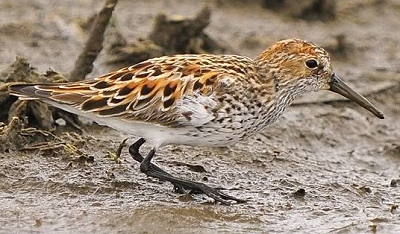
Here is an adult Western Sandpiper in late July who has flown north to breed and is now on its way back south for the winter using the same feathers from May. The bird’s breast pattern is still noticeable but the bright colours on the back and head have all but faded.
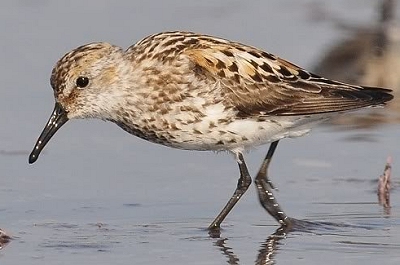
Give the bird above another month or so and it will continue to molt to its grey winter plumage. This bird is almost completely molted to winter plumage but note a couple remaining breast arrowheads as well as just a few rufous/brown feathers sprinkled in the wing and back. An even closer examination will show brownish and worn flight feathers which will also soon be molted and replaced with fresh new feathers. A peep in winter colours is even more difficult to identify. Lucky for us, not many species are still kicking around in the winter in B.C.
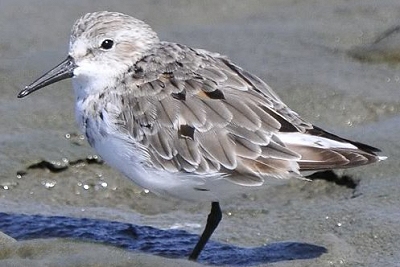
This Western Sandpiper is completely molted to winter plumage.
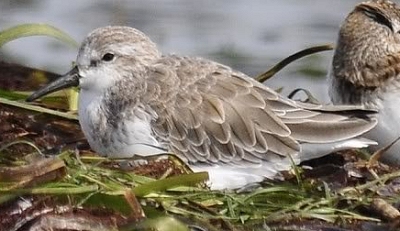
Depending on the species, the southwards migration for shorebirds can begin as soon as late June. Adult birds will leave the breeding grounds first followed two to three weeks later by their young. By August, a good many shorebirds being seen are juveniles.
Juvenile Western Sandpipers are distinct again from the different plumages of adult birds. Their plumage is much fresher and brighter with a distinct rufous patch of feathers on the back (a feather group called the scapulars). The juveniles too will molt to grey later in the fall. When the bird pictured below begins its northward migration starting in April, it will look mostly like the breeding plumaged adult pictured above but maybe not quite as bright.
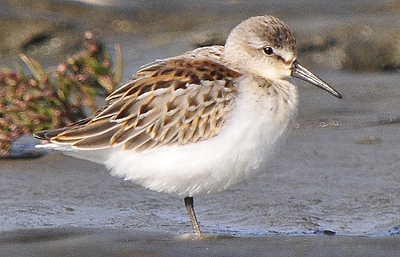
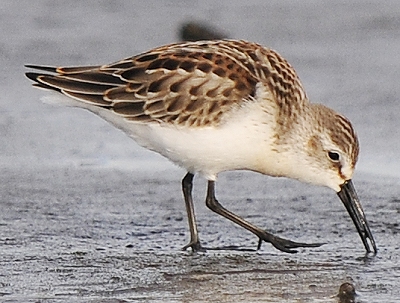
So, there’s a break down on aging a shorebird. Again, it’s good to determine the age if possible. Obviously in the spring the birds you see will be adults in breeding plumage. This makes it marginally easier to identify them in the spring. Come fall there will be much more variety between adults in various stages of molt and the juveniles who, as the fall goes on, will start to show some signs of molt as well.
Let’s take a look at the most common species of ‘peeps’ we find around here.
Least Sandpiper
Easily the most common species of them all in our checklist area and a great species to learn first. As the name suggests, they are the smallest of the sandpipers. Size, however, is not necessarily all that helpful if the bird is by itself. But next to a Western Sandpiper however, the difference is noticeable. The flock in the picture below is of four Leasts and a Western Sandpiper all in breeding plumage in late April.
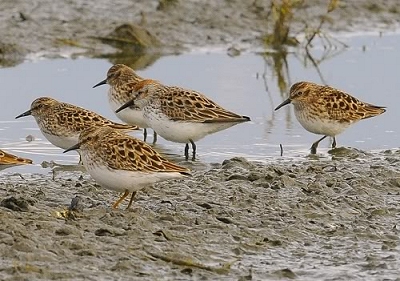
Least Sandpipers have greenish-yellow legs but while a good fieldmark, is not one easily seen especially at a bit of a distance on a little bird that may have its legs in water or behind grass. Also, these little birds are not scared to get dirty which means green legs can quickly become very dark looking with a coating of mud. Their bills are not very long and droop to a bit of a point. A Least Sandpiper’s posture is often crouched which makes it look even shorter legged than it is. The plumage in breeding and juveniles is similar but even brighter on the juveniles as is expected. Their plumage brightness is also fairly consistent on the wings and back with no obvious contrast that sticks out like It might, say , on a Western Sandpiper. I get the feeling of ‘darker and richer brown’ when I see a Least Sandpiper.
An adult Least Sandpiper in late April
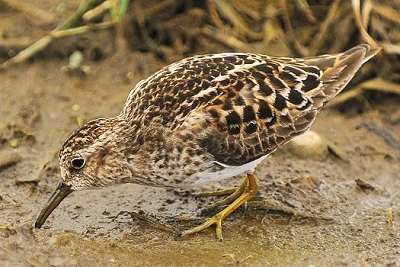
An adult Least Sandpiper in winter plumage (with one last yet to be molted black feather on the wing). Yes, very similar to the Western Sandpiper in winter plumage!
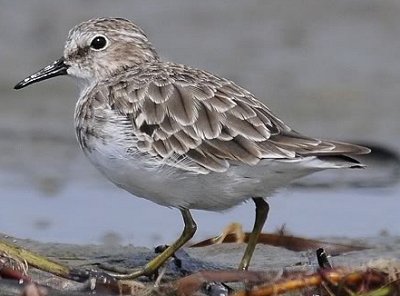
A juvenile Least Sandpiper
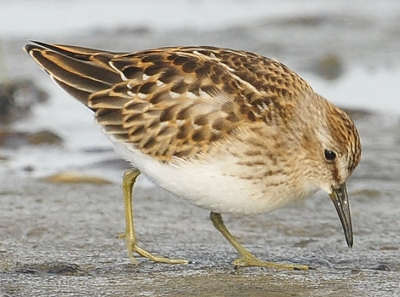
Western Sandpiper
The next common species is the Western Sandpiper. They’re not overly common here and I’ve never seen them outnumber the Least Sandpipers. Out on Boundary Bay they occur by the thousands though! A mid-sized peep with a longer bill that curves downwards slightly. Since shape is useful, especially when one gets more familiar with the different species, it is noteworthy that a Western seems a bit more chunky and large-headed of the sandpipers when compared to the Semipalmated and Least. Adults in breeding plumage have rufous markings on the head and back (scapulars) Juveniles likewise have bright rufous colour on their scapulars creating a contrasting patch. Their legs are black, but as mentioned earlier, leg colour is not always reliable. See the photos above in the introduction to see the Western Sandpiper that illustrate the descriptions.
Semipalmated Sandpiper
We have only a handful of records of this species in our checklist area. Similar in size to the Western Sandpiper and also with black legs the Semipalmated is a bit smaller. The head looks a bit more rounded and the bill is usually shorter, straighter and a bit thicker looking than on most Western Sandpipers. Like the Least Sandpiper, their plumage is more uniform but not as rich a brown.
A juvenile Semipalmated will often be darker and more scaly looking on the wings and back than a Western. The contrasting rufous scapulars found on the Western is lacking on the Semipalmated. The face and head of a Semipalmated tends to be a bit darker too on some individuals. Some variation does occur among the shorebirds and the Semipalmated Sandpiper makes no exception to this as can be seen in the photos below.
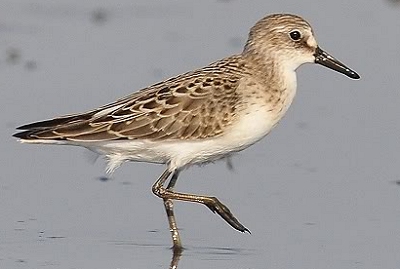 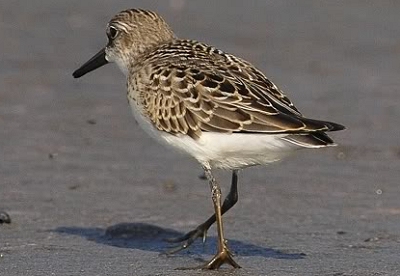
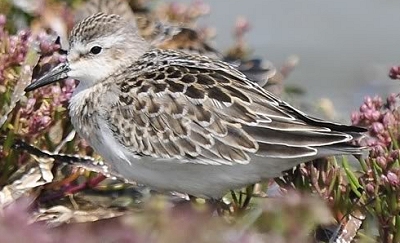
The bird below is a brighter individual with the scapulars a bit more colourful. 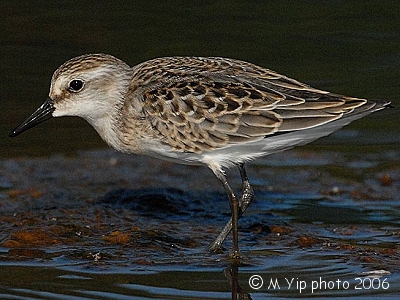
The next bird is quite a bit paler. 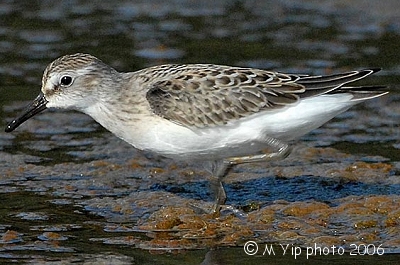
As hinted earlier, the bill length and shape is not foolproof. Bill lengths do vary and a female bird has a longer bill than the males. Thus, a short Western Sandpiper bill can look very much like a Semipalmated’s. According to Kenn Kaufman in Advanced Birding, Semipalmated Sandpipers in the west of North America tend to have shorter bills than the ones that travel down the east. We’re lucky there but all the same, it is not advisable to rest identification on just one field mark; these birds can and will vary! The following series of photographs will illustrate this well.
An obvious Western Sandpiper with a nice long and drooped bill.
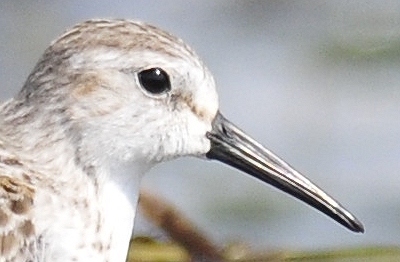 A bit shorter of a specimen on a Western Sandpiper.
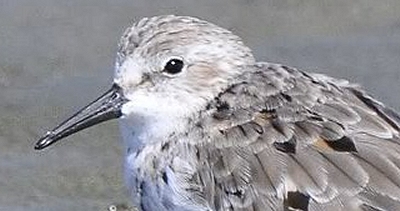
Yikes, this Western Sandpiper is not much different from a Semipalmated!
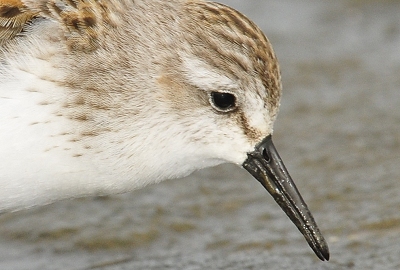
A ‘typical’ Semipalmated’s bill attached to a Semipalmated Sandpiper. Note the blunt look to the tip and the bit of a heavier and thicker feel to the bill overall.
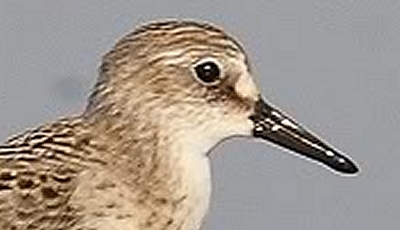
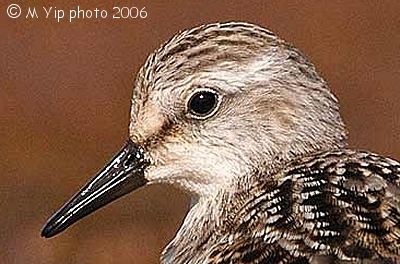
A very short-billed specimen of a Semipalmated Sandpiper.
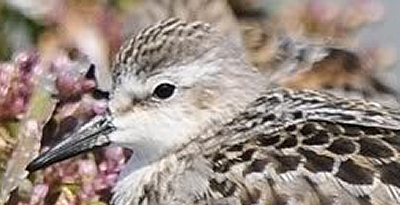
Baird’s Sandpiper
Rare in our checklist area this species is a long-distance migrant that tends to travel through the Prairies. The largest yet of the peeps described in this article, a Baird’s Sandpiper also comes across as a more slender bird. This is due in part to the long wings which is a typical feature of many birds that migrate long distances. The bill is straight and rather narrow. The legs are black. More so than the other three sandpipers, Baird’s can be found on dry habitats such as turf farms or well above the water line of ponds.
Adults are even more rare in our checklist area and has been recorded only once. This is because this species often migrates non-stop between summer and wintering grounds and does not stop on the way! An adult Baird’s will be a more sandy grey-brown with large black spots.
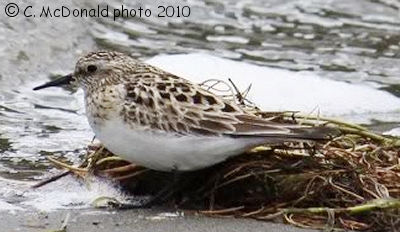
Juveniles are a buffy brown and have a strong scaly pattern on the back. The wings project far past the tail as you can see in the picture below of a juvenile. No rufous colouring to be found on these guys.
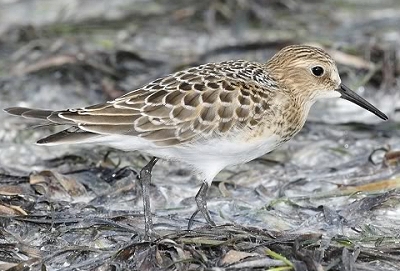
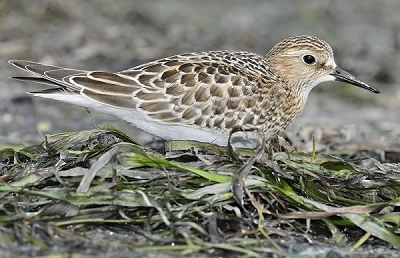
Sanderling
A bit larger than the Baird’s Sandpiper, most records we get are of juveniles which are quite a striking black and white patterned bird. Non breeding adults are usually into molt by the time they get down here but can look a bit exciting at first with patches of dark rufous colours left on the neck and head.
Here is a juvenile Sanderling.

Dunlin
This solidly built shorebird is larger than the peeps with a long and noticeably downwards curved bill. In breeding plumage, is quite distinct with the black belly patch and rufous back and wings. A later migrant, not many are seen until later October after most of the other species are gone. By fall, the birds are brownish grey in their winter colours and much darker than the lighter grey of the winter plumaged Western Sandpiper.
Breeding plumage in April 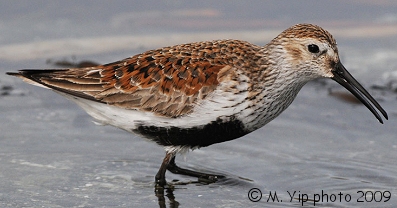
A Dunlin well into molt
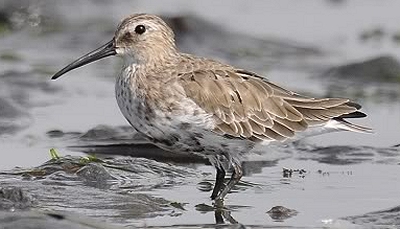
A fully molted Dunlin
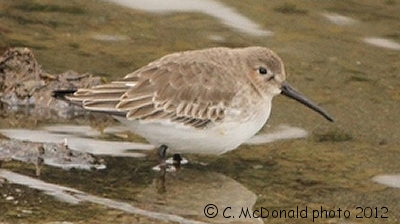
Pectoral Sandpiper
Almost the size of an American Robin, this shorebird is the largest of all shorebirds we’ve discussed in this article. For all intents and purposes, the Pectoral Sandpiper looks like a massive Least Sandpiper both in breeding and juvenile plumages. Pectoral Sandpipers have greenish yellow legs, slightly curved bills but their breast pattern is very dense and contrasts abruptly with the white belly. This species does not necessarily require water in its feeding habitats so also watch for them in turf fields and other short grass habitats. The Pectoral Sandpiper is a later fall migrant as well with peak numbers starting to show in middle September.
A breeding plumaged adult.
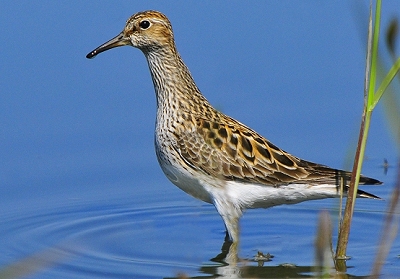
Juveniles do not look much different when they come down in the fall from where they hatched up north.
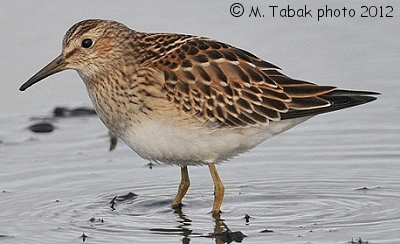
In Closing
I hope this article was helpful in giving some pointers and encouragement on identifying some sandpipers. A good book, asides from the field guides, that goes a little more in depth into this topic is a Peterson Field Guides Advanced Birding by Kenn Kaufman. I used it a lot when I was getting going and still refer to it today. Do get out and start looking at the little fellas as much as you can. Once you get the more common ones pinned down, expanding into the other less common ones will get easier and easier. As in identifying gulls, there are always odd-looking individuals that defy all attempts at identification. Don't worry about those as this happens even to the best of us. It's what makes it fun! Regardless of how often you're able to get out and how rapidly you get to know the shorebird species, it will always be entertaining watching them go about their lives.
|